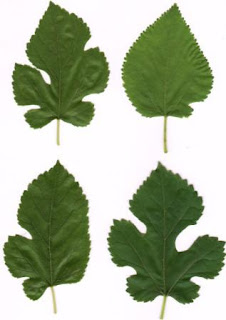In early- to mid-June, you are likely to start noticing purple bird droppings everywhere. You will also see a select group of people in-the-know with telltale purple stains on their fingertips. The culprit: mulberries.
Morus rubra is a native tree related to the Asian mulberry trees (morus alba) used to raise silkworms. In fact, you'll find both growing in this area, because at some point there was an attempt to establish a silk industry on the East Coast. Rubra berries darken from white to red to a deep purple as they ripen. Alba berries remain white but get softer when ripe. Despite their different continents of origin, the two species are closely enough related that you may also see hybrid trees with fruits that are mixed colors or a lighter purple when ripe.
Both species of mulberries are edible, and they're hard to confuse with anything else: there aren't any other local trees bearing fruit that looks like this. The berries look like blackberries, but those grow on canes coming out of the ground, not on tree branches, and they won't come until later in the summer.
Mulberries can be used like other berries: eaten raw or cooked into cobblers, pies, jams, or any other fruit recipe. The flavor is much less tart than many other berries, so you may find you like them better with a little lemon juice or mixed with another fruit. Unripe berries can make you sick. You want berries that are soft, and practically falling off the tree.
In fact, one good way to spot a tree with ripe mulberries is that the fruit will start falling to the ground: if you see purple spots on the sidewalk or street, look up and you're likely to see fruit on the branches as well. This tendency of the fruit to fall when ripe leads to an easy way to harvest large quantities: put a tarp or a sheet on the ground and shake the branches over it. You'll have to sort through the assorted bits and pieces that fall down, but it's still much faster than picking individual berries.
In the wild: Actually, you're most likely to spot this tree in residential neighborhoods, especially along fences where birds have sat after eating mulberries. Most homeowners will be more than happy to have you take some of their berries before they fall on the ground and make a mess. There are some along the paved path in the Peirce Mill area of Rock Creek Park.
In your yard: Because of the aforementioned mess of dropping fruits, most homeowners avoid planting this tree. On the other hand, you and the birds will both be well-fed, and they grow like weeds. The native morus rubra grows to about 40 to 70 feet, so make sure you have enough space before planting.
Getting outside, inside the beltway: tips on getting outdoors in the Washington, DC area.
Most Popular Posts
-
Photo credit: ilkerender Last year we listed places to swim near DC and places to rent a canoe near DC . Today we return to complete the s...
-
Summer calls out for being on the water. We've found more than a dozen locations where you can rent a canoe or kayak in the Washington, ...
-
What a lovely break in the heat we're having. Here are some things to keep an eye out for in August. Links are to previous LOOK FOR post...
-
This spring has been cold and a little slow, like last year. Morels , in particular, are just starting to show up. Below are all the things ...
-
The Jack in the pulpits are starting to unfurl right now. I've always loved these flowers, showy in their design rather than their color...
-
I've been distracted from the Natural Capital but I haven't totally forgotten about you guys...Here are some of the other things we ...
-
This time last year, the wood frogs were out and had already laid their eggs. As of this morning, the pond where we always find them was com...
-
Our monthly roundup of things to look for this month: Photo credit: InspiredinDesMoines I originally wrote about bald eagles for t...
-
Two of the things we love best about living in the DC metro area are the public transportation system, and the parks. And so, one of our mai...
-
If I had to name my biggest frustration with the nature around DC, the lack of good swimming holes might top the list. Until 7th grade I liv...
